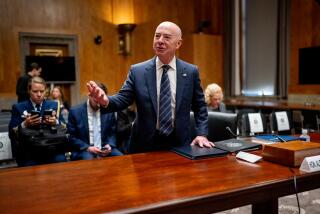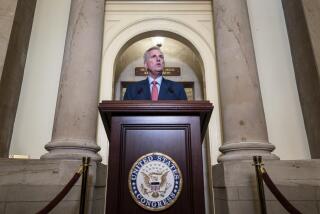The Man They Love to Hate
- Share via
WASHINGTON — Why is Bill Clinton’s presidency in such peril? Surely, there is some explanation for the increasingly surreal impeachment proceedings underway in Washington. In contrast to the stormy 1860s or 1970s, the only other times impeachment has been on the congressional agenda, the national mood is tranquil to the point of complacency. Even if the most serious of the allegations against Clinton are true, they are small potatoes compared with the constitutional crimes charged against presidents Andrew Johnson and Richard M. Nixon. And whereas Johnson and Nixon were clenched, prickly and paranoid men, easy to hate, Clinton seems just the opposite.
Yet, almost everywhere one turns inside the Beltway, among journalists and politicos across the political spectrum, there is contempt for the president, in startling contrast with general public opinion. That contempt, reflected in the elite as well as the tabloid news media, has been a catalyst in turning Clinton’s relatively minor misdeeds, alleged and admitted, into potentially impeachable offenses. So why do they hate Clinton so much?
A lot depends on how you define “they.” Contrary to the arguments of the president’s staunchest supporters, his opponents do not form a vast right-wing conspiracy (though some of Clinton’s far-flung reactionary political enemies have certainly plotted to bring him down). Different people with different political beliefs dislike Clinton for different reasons, and, in recent months, they have met in a harmonic convergence of hatred.
Still, there is a pattern of sorts to the anti-Clinton fervor, rooted in recent U.S. history. Across the board, Clinton is paying dearly for unfinished American business left over from the 1960s and 1970s: the traumas of civil rights, the Vietnam War, countercultural upheaval and Watergate that still shape our politics nearly 30 years later, despite Clinton’s best efforts to exorcise them.
After 1966, American national politics became polarized as at no time since the Civil War and Reconstruction. The turn from civil rights to black power, along with protests against the Vietnam War, pushed the Democratic Party well to the left. The Republican Party’s defense of the war, exploitation of white voters’ racial resentments and eventual alliance with ultraconservative evangelicals pushed it well to the right. The Watergate scandals, Jimmy Carter’s failed presidency and the election of Ronald Reagan each, in turn, deepened the ideological and political breach.
The political middle, traditionally the staging ground of our public life, virtually ceased to exist. By the mid-1980s, it was hard to remember that the GOP once included figures as liberal as former Supreme Court Justice Earl Warren and Vice President Nelson A. Rockefeller, or that the likes of Sen. Henry M. “Scoop” Jackson and House Speaker Sam Rayburn had been leading Democrats. Polarization became a normal state of affairs in Washington, one that guaranteed control of the White House to the rip-roaring GOP and control of Congress to the dazed-and-confused Democrats, a division that gave the political initiative to the right. Outside the capital, the country was riven by the so-called culture wars, fallout from the ‘60s that seemed to preclude national unity.
In 1992, Clinton assumed leadership of an insurgency--what some have called a revolt of “the radical middle”--that aimed to topple this state of affairs. Clinton perceived that the Democrats would never regain the White House unless they rethought their stale assumptions about big-government liberalism. He would replace the old shibboleths with a limber centrist liberalism and engage constructively with his opponents; preserve the spirit of reform, embrace the feminist and civil-rights breakthroughs of the ‘60s, and preach an ethic of hard work and individual responsibility. Other Democratic hopefuls had similar ideas; Clinton alone had the charm, the clarity of purpose and the political muscle to endure and win a grueling, dirty national campaign. As he soon learned, however, governing proved even more difficult than running.
His problems have been personal and cultural as well as political. Clinton’s carefully honed persona was bound to shatter the nerves of many conservatives. (It’s hardly surprising that Clinton fares worst in the opinion polls among older, white, Southern men.) From the start of his political career in Arkansas, Clinton was hounded by superpatriotic, erstwhile hard-line segregationists, notably the former state Supreme Court Justice Jim Johnson and his associates, whose hatred of Clinton’s views on civil rights and the Vietnam War led them to charge him with all sorts of fantastic crimes, from drug smuggling to murder. (Many members of this coterie appear in the Gennifer Flowers, Paula Corbin Jones and Whitewater investigations.)
After Clinton won the presidency, conservatives in and out of Arkansas would not bring themselves to accept his victory. Apart from his political heresies, here was a plainly sensuous man, still in his 40s, who enjoyed overeating and all the other pleasures of the flesh, a most unpresidential figure, indeed. Here was a man who (too aggressively, perhaps) pushed his wife forward as his professional equal, entailing a new concept of the first family that was frightful to family-values conservatives.
At the same time, however, Clinton’s flexible political style enraged many freethinkers of his own generation, including large sectors of the sophisticated, university-trained media elite, who had once marched against Presidents Lyndon B. Johnson and Nixon. If puritanical traditionalists beheld Clinton as the rotten fruit of the counterculture, many veterans of the counterculture despised him as a sellout, a dissimulator, a man whose very lack of fixity was proof of his spiritual depravity. As the journalist Paul Berman has written, the ‘60s culture, though it appeared to some as the libertine overthrow of all morality, “was most of all a movement against hypocrisy and falsity (at least it meant to be).” Clinton’s lip-biting, schmoozy, seductive political self did not appeal to those who had been shaped by the ‘60s antipolitical true faith. Quite the opposite, it offended them as the outward sign of the deepest personal corruption. The fact that he claimed to stand for something new in politics only offended them all the more.
Clinton’s political insurgency, meanwhile, met stiff resistance from the polarized Washington establishment. Republicans were aghast that any Democrat had gained the White House after Reagan, let alone someone who broke the familiar ‘60s liberal ideological mold. Some went so far as to echo the charge that because Clinton had won with a mere plurality, his presidency was somehow illegitimate. Greatly emboldened and pushed further right by the 1994 congressional elections, the GOP has continued its tirades ever since, calling for Clinton’s impeachment long before the current crisis.
Democratic ideologues and insiders, meanwhile, greeted the new president warily and with minimal cooperation. Clinton’s insurgency threatened them, too, ideologically and politically. They were quick to perceive his maneuverings and unorthodox rhetoric as treasonous. Most portentously, when Clinton presented, as the domestic centerpiece of his first term, an ambitious, centrist national health-care plan, Democratic liberals fatefully backed off and also chose to fight the administration over the North American Free Trade Agreement.
The Democrats’ comeuppance came in the 1994 elections, when the GOP seized control of the House. With the right wing in the ascendancy in 1995, Clinton had no choice but to play defensive politics, not least to preserve his chance for a second term, conceding where he had to, outsmarting the GOP where he could and trying, by trickery when necessary, to steal Congress’ thunder while pushing his own agenda in a piecemeal, V-chip fashion. Clinton won reelection, but his maneuvering only deepened Democrats’ mistrust of a man whom they saw as, at best, a shallow opportunist and, at worst, a Republican in Democratic clothing.
And so, having failed to consolidate the political center, Clinton was left virtually alone when the full force of the embarrassing Monica S. Lewinsky matter broke last January. Indeed, the Lewinsky story--first the sex, then the lying--proved a lightning rod for the disparate currents of anti-Clintonism. To the dogmatic, unforgiving right, which knows no sense of proportion when it comes to sin, Clinton’s behavior was proof positive that he is a son of Beelzebub. To the high-minded liberal, for whom lying and hypocrisy are cardinal offenses, Clinton had at last exposed himself as a mendacious fraud. Republicans, who could barely contain their glee, moved quickly in August to initiate impeachment proceedings. Democrats (apart from the Congressional Black Caucus), refrained for crucial weeks to speak out on his behalf, viewing his legalistic hairsplitting as the final betrayal. And all the while, the country, two-thirds of it, anyway, which shared little if any of the hatred or grudges of Clinton’s attackers, looked on with growing amazement.
Barring a GOP landslide next month, Clinton will probably survive this bizarre business. Even now, Democrats have begun to rally and to redirect their anger at Kenneth W. Starr, the independent counsel. As public support for Congress dwindles, cooler heads among the Republicans may prevail over the most zealous Clinton haters in the GOP. Even if the House votes for impeachment, it is difficult to imagine that 67 senators will vote to throw Clinton out. But after the hysteria abates, the damage will have been done to hopes that the nation might overcome the suspicions, divisions and dogmatic politics of the past three decades. Clinton tried. See what happened.
More to Read
Get the L.A. Times Politics newsletter
Deeply reported insights into legislation, politics and policy from Sacramento, Washington and beyond. In your inbox twice per week.
You may occasionally receive promotional content from the Los Angeles Times.










